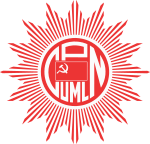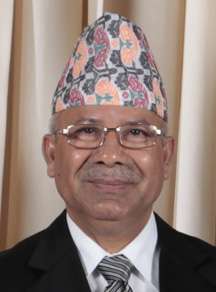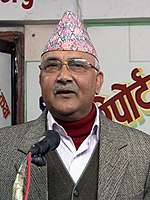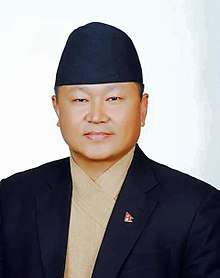Communist Party of Nepal (Unified Marxist–Leninist)
The Communist Party of Nepal (Unified Marxist–Leninist) (abbreviated CPN (UML); Nepali: नेपाल कम्युनिष्ट पार्टी (एकीकृत मार्क्सवादी-लेनिनवादी) was one of the two major communist parties in Nepal from 1991 to 2018. The party was formed in January 1991 with the unification of the Communist Party of Nepal (Marxist) and the Communist Party of Nepal (Marxist–Leninist).
Communist Party of Nepal (Unified Marxist–Leninist) नेपाल कम्युनिष्ट पार्टी (एकीकृत मार्क्सवादी-लेनिनवादी) | |
|---|---|
 | |
| Leader | KP Sharma Oli |
| Founded | 6 January 1991 |
| Dissolved | 17 May 2018 |
| Merger of | CPN (Marxist) CPN (Marxist–Leninist) |
| Succeeded by | NCP[1][2][3] |
| Headquarters | Aakirti Marg, Dhumbarahi, Kathmandu, Nepal |
| Ideology | Communism Marxism-Leninism People's Multiparty Democracy |
| Political position | Centre-left[4][5][6] to left-wing[7][8] |
| International affiliation | IMCWP |
| Election symbol | |
| Party flag | |
 | |
| Website | |
| www | |
The CPN (UML) led four governments: from 1994 to 1995 under Man Mohan Adhikari, from 2009 to 2011 under Madhav Kumar Nepal, in 2011 under Jhala Nath Khanal, and from 2015 to 2016 under KP Sharma Oli. The party was also a junior partner in five coalition governments: in 1997 under Lokendra Bahadur Chand, from 1998 to 1999 under Girija Prasad Koirala, from 2008 to 2009 under Pushpa Kamal Dahal, from 2011 to 2013 under Baburam Bhattarai, and from 2014 to 2015 under Sushil Koirala.[9]
The party dissolved on 17 May 2018 to make way for the Nepal Communist Party in a merger with the Communist Party of Nepal (Maoist Centre).
History
Founding, 1991–1993
The United Left Front was formed in 1990 to protest the Panchayat system and restore multi-party democracy. They organized a joint movement with the Nepali Congress, and King Birendra yielded to their Jana Andolan in November 1990. Two constituents of the United Left Front (the Communist Marxist and Marxist–Leninist parties) merged on January 6, 1991 to form the Communist Party of Nepal (Unified Marxist–Leninist) before the 1991 elections, and the United Left Front became inactive.[10]
In the 1991 elections, the party won 69 of 205 seats and was the second-largest party in the House of Representatives.[9] Man Mohan Adhikari was elected head of the parliamentary group, and became the Leader of the Opposition in May 1991. The fifth party congress was held in Kathmandu in January 1993, and People's Multiparty Democracy was adopted as its main ideology. Adhikari was elected chairman, and Madan Bhandari was elected general secretary. Bhandari was killed in a vehicle accident in Chitwan later that year, and Madhav Kumar Nepal became the party's general secretary.[10]
First government, 1994–1997
After the mid-term elections in 1994, the party won 88 of 205 seats in a hung parliament and formed a minority government under Man Mohan Adhikari.[9] The government lasted for nine months after Adhikari was forced to resign when he lost a no-confidence motion in September 1995. The party was back in the government in March 1997, after supporting the Surya Bahadur Thapa-led Rastriya Prajatantra Party (RPP) government. Following dissension in the RPP, Lokendra Bahadur Chand resigned and CPN (UML) returned to the opposition.[9][10]
Split, 1998–1999
The party faced its first split in March 1998, after disagreements about a water-sharing agreement with India. The new party formed with 46 legislators from the mother party as the Communist Party of Nepal (Marxist–Leninist), under the leadership of Bam Dev Gautam. The party joined the government again in December 1998, backing the Girija Prasad Koirala-led Nepali Congress-Nepal Sadbhawana Party coalition government.[10] In the 1999 elections, the party won 70 of 205 seats and was the second-largest party in the House of Representatives.[9]
Direct rule under King Gyanendra, 2002–2006
Most members of the Communist Party of Nepal (Marxist–Leninist) rejoined the parent party on February 15, 2002, and the others decided to restructure the existing party.[10] The party's seventh general convention was held in Janakpur on February 1–6, 2003. The convention decided to abolish the post of party chair, vacant after the death of Man Mohan Adhikari and Madhav Kumar Nepal's unanimous reelection as general secretary of the party.
When King Gyanendra dissolved Parliament and sacked Prime Minister Sher Bahadur Deuba of Nepali Congress (NC) in 2003, five other parties protested his decision. However, when Deuba was reinstated CPN (UML) joined the provisional government with Bharat Mohan Adhikari as deputy prime minister. This government was dissolved by the king on February 1, 2005. A Seven Party Alliance was formed to protest his decision and, following an agreement with the Communist Party of Nepal (Maoist), a joint struggle was launched against the king's direct rule. On April 10, 2006, Parliament was reconvened by the king and a government was formed under Girija Prasad Koirala.[10]
Constituent Assembly, 2008–2015
In the 2008 Constituent Assembly elections, the party won 108 of 605 seats and finished third. Madhav Kumar Nepal resigned as general secretary, and was replaced by Jhala Nath Khanal. The party backed Communist Party of Nepal (Maoist) candidate Pushpa Kamal Dahal, and joined his government in August 2008.[11] Khanal was elected party chairman and Ishwor Pokhrel general secretary by the eighth general convention in Butwal in February 2009.
.jpg)
In early May 2009, the CPN (UML) joined several other parties in leaving Dahal's coalition government after he sacked Army Chief of Staff Rookmangud Katawal.[12] Following their withdrawal, they formed a new coalition government with the Nepali Congress and the Madhesi Jana Adhikar Forum under Madhav Kumar Nepal.[13] Nepal resigned in June 2010 after failing to draft a new constitution.[14] Following more than seven months of political stalemate, Khanal was elected prime minister in February 2011 with support from the Unified Communist Party of Nepal (Maoist).[15] He resigned in August after he failed to reach a consensus with the other parties on drafting a new constitution and the peace process.[15] The party joined the next government, led by Baburam Bhattarai, on August 28, 2011.[16]
Following Bhattarai's dissolution of the Constituent Assembly of Nepal when it failed to draft a new constitution before the deadline,[17] the CPN (UML) became the second-largest party after winning 175 of 575 elected seats in the 2013 elections. The party joined a coalition government with the Nepali Congress and the Rastriya Prajatantra Party under Sushil Koirala.[18] In July 2014, Khadga Prasad Oli became party chair after he defeated Madhav Kumar Nepal in the party's ninth general convention.[19] The new constitution was delivered by this government on September 20, 2015.[20]
Final years and dissolution, 2015–2018
After the new constitution was drafted, Sushil Koirala resigned and Khadga Prasad Oli was elected prime minister with support from the Unified Communist Party of Nepal (Maoist), the Rastriya Prajatantra Party and other parties.[21] Oli resigned on July 2016 before a motion of no confidence supported by the Nepali Congress and the Communist Party of Nepal (Maoist Centre).[22]
In the 2017 local elections, the party won 14,099 seats (including 294 mayoral or chairman positions) and became the largest local-government party. The party elected mayors in major cities, including Kathmandu and Pokhara Lekhnath.[23][24] It announced an alliance with the Communist Party of Nepal (Maoist Centre) before the 2017 legislative and provincial elections.[25] The party won 121 seats, becoming the largest party in the House of Representatives,[26] and became the largest party in six of Nepal's seven provinces.[27] After the election, the party maintained its alliance with the Communist Party of Nepal (Maoist Centre) and formed coalition governments in Nepal's centre and six of the seven provinces. According to the power-sharing agreement, the CPN (UML) would lead governments in Province No. 1, Bagmati Pradesh, Gandaki Pradesh and Province No. 5.[28]
In the February 6, 2018 National Assembly elections, the CPN (UML) won 27 of 56 contested seats and again became the country's largest party.[29] Party chairman Oli was elected the party's parliamentary leader in the House of Representatives and appointed prime minister on February 15.[30] Bidhya Devi Bhandari was re-elected president on March 13.[31]
After eight months of planning, the Unification Coordination Committee met to finalize plans for merging Nepal's two dominant left-wing parties. On May 17, 2018, the party dissolved. Its members joined the Nepal Communist Party in a merger with the Communist Party of Nepal (Maoist Centre).
Electoral performance
Nepalese legislative elections
| Election | Leader | Votes | Seats | Position | Resulting government | ||
|---|---|---|---|---|---|---|---|
| # | % | # | +/- | ||||
| 1991 | Madan Bhandari | 2,040,102 | 27.98 | 69 / 205 |
2nd | Congress | |
| 1994 | Man Mohan Adhikari | 2,352,601 | 30.85 | 88 / 205 |
CPN (UML) minority | ||
| 1999 | Madhav Kumar Nepal | 2,728,725 | 31.66 | 71 / 205 |
Congress | ||
| 2008 | Madhav Kumar Nepal | 2,229,064 | 21.63 | 108 / 601 |
CPN (Maoist)–CPN (UML)–MJFN | ||
| 2013 | Jhala Nath Khanal | 2,492,090 | 27.55 | 175 / 575 |
Congress–CPN (UML)–RPP | ||
| 2017 | Khadga Prasad Oli | 3,173,494 | 33.25 | 121 / 275 |
CPN (UML)–CPN (Maoist Centre) | ||
Provincial Assembly elections
As of the 2017 provincial elections, CPN (UML) is the largest party in six out of seven provinces and heads the government in four provinces.
| Province | Seats in 2017 |
|---|---|
| Province No. 1 | 51 / 93 |
| Province No. 2 | 21 / 107 |
| Bagmati Pradesh | 58 / 110 |
| Gandaki Pradesh | 27 / 60 |
| Province No. 5 | 41 / 87 |
| Karnali Pradesh | 20 / 40 |
| Sudurpashchim Pradesh | 25 / 53 |
Leadership
Chairmen
- Man Mohan Adhikari, 1991–1999
- Jhala Nath Khanal, 2009–2014
- Khadga Prasad Oli, 2014–2018
General secretaries
- Madan Bhandari, 1993
- Madhav Kumar Nepal, 1993–2008
- Jhala Nath Khanal, 2008–2009
- Ishwor Pokhrel, 2009–2018
Prime Ministers of Nepal
| Name | Portrait | Periods in office |
|---|---|---|
| Man Mohan Adhikari | 1994–1995 | |
| Madhav Kumar Nepal |  |
2009–2011 |
| Jhala Nath Khanal | .jpg) |
2011 |
| Khadga Prasad Oli |  |
2015–2016, 2018–current |
Chief Ministers
| Province | Portrait | Name | Periods in office |
|---|---|---|---|
| Province No. 1 |  |
Sher Dhan Rai[32] | 2018–present |
| Bagmati Pradesh | Dormani Poudel[33] | 2018–present | |
| Gandaki Pradesh | Prithvi Subba Gurung[34] | 2018–present | |
| Province No. 5 | Shankar Pokhrel[35] | 2018–present |
Sister organizations
- General Federation of Nepalese Trade Unions
- Youth Association of Nepal
- All Nepal National Free Students Union
- All Nepal Women's Association
- All Nepal Peasants Association
- All India Nepalese Free Students Union
- Nepal National Teachers Association
- National People's Cultural Forum
- Democratic National Organization of Persons with Disabilities–Nepal
See also
- Communist Party of Nepal
- Communist Party of Nepal (Marxist–Leninist)
- Communist Party of Nepal (Marxist)
- Communist Party of Nepal (Marxist–Leninist) (1998)
References
- https://thehimalayantimes.com/kathmandu/ncp-commits-to-social-justice-and-economic-prosperity-co-chairs-pm-oli-and-dahal/
- "UML and Maoist Centre to form Nepal Communist Party tomorrow". 16 May 2018.
- "Nepal: Left alliance unifies to form single party". www.aninews.in.
- "Political parties CPN (UML)".
- "Where the Marxist-Leninists are the moderate option".
- "Liberal parties win Nepal's election as Maoist vote crumbles". Archived from the original on 2017-09-12. Retrieved 2017-06-24.
- "Nepal: Key people and parties". Insight on Conflict. Peace Direct. Retrieved 11 September 2017.
- "Healthy turnout, little violence reported in historic poll". RFI. RFI. April 2008. Retrieved 11 September 2017.
- 1936-, Brass, Paul. R. (Paul Richard). Routledge handbook of South Asian politics : India, Pakistan, Bangladesh, Sri Lanka, and Nepal. ISBN 0415716497. OCLC 843078091.CS1 maint: numeric names: authors list (link)
- Tom, Lansford (2015-03-24). Political handbook of the world 2015. ISBN 9781483371580. OCLC 912321323.
- Pokharel, Tilak; Sengupta, Somini (2008-08-15). "Nepal Elects a Maoist to Be the Prime Minister". The New York Times. ISSN 0362-4331. Retrieved 2017-06-26.
- "South Asia | Nepal communists quit in protest". BBC News. May 3, 2009. Retrieved August 18, 2013.
- "Madhav Kumar Nepal sworn-in as PM of Nepal — Livemint". www.livemint.com. Retrieved 2017-06-26.
- Marasini, Prerana. "Nepal Prime Minister resigns". The Hindu. Retrieved 2017-06-26.
- "Nepal: Jhalanath Khanal elected new prime minister". BBC News. 2011-02-03. Retrieved 2017-06-26.
- "Baburam Bhattarai elected prime minister of Nepal". BBC News. 2011-08-28. Retrieved 2017-06-26.
- "Nepal parties resign as constitution deadline passes". BBC News. 2012-05-28. Retrieved 2017-06-26.
- "Sushil Koirala wins vote to be Nepal's prime minister". BBC News. 2014-02-10. Retrieved 2017-06-26.
- "KP Oli elected UML Chairman — Nepali Headlines,Nepal News, Nepali News, News Nepal". nepaliheadlines.com. Retrieved 2017-06-26.
- "Nepal's new constitution endorsed through Constituent Assembly — Xinhua | English.news.cn". news.xinhuanet.com. Retrieved 2017-06-26.
- Sharma, Bhadra; Barry, Ellen (2015-10-11). "Nepal Elects K.P. Sharma Oli as New Prime Minister". The New York Times. ISSN 0362-4331. Retrieved 2017-06-26.
- Sharma, Bhadra (2016-07-24). "Nepal's Prime Minister, K. P. Sharma Oli, Resigns Ahead of a No-Confidence Vote". The New York Times. ISSN 0362-4331. Retrieved 2017-06-26.
- "UML's Shakya elected Kathmandu mayor". Retrieved 2018-04-18.
- "UML wins mayor, deputy mayor in Pokhara Lekhnath metropolis". Retrieved 2018-04-18.
- "CPN-UML and CPN-Maoist Centre form alliance in Nepal". hindustantimes.com/. 2017-10-03. Retrieved 2018-04-18.
- "Nepali Communists win landslide, but face big obstacles to win change". Green Left Weekly. 2018-01-05. Retrieved 2018-04-18.
- "Nepal's CPN-UML emerges as largest party in historical elections - Xinhua | English.news.cn". www.xinhuanet.com. Retrieved 2018-04-18.
- "UML to get 4 chief ministers, Maoist Centre 2". Retrieved 2018-04-18.
- "Left alliance wins 27 seats, Nepali Congress 5 in Nepal polls". The Hindu. PTI. 2017-12-09. ISSN 0971-751X. Retrieved 2018-04-18.CS1 maint: others (link)
- "KP Sharma Oli appointed Nepal's new prime minister". www.aljazeera.com. Retrieved 2018-04-18.
- "Bidya Devi Bhandari re-elected Nepal's president". hindustantimes.com/. 2018-03-13. Retrieved 2018-04-18.
- "Sher Dhan Rai appointed Province 1 Chief Minister - The Himalayan Times". The Himalayan Times. 2018-02-14. Retrieved 2018-03-31.
- "UML PP leader Dor Mani Paudel appointed CM of Province 3". The Himalayan Times. 2018-02-11. Retrieved 2018-03-31.
- "Prithvi Subba Gurung appointed as Province 4 CM - The Himalayan Times". The Himalayan Times. 2018-02-12. Retrieved 2018-03-31.
- "Shankar Pokharel appointed Province 5 CM". The Himalayan Times. 2018-02-14. Retrieved 2018-03-31.
External links
| Wikimedia Commons has media related to Communist Party of Nepal (Unified Marxist–Leninist). |
- Official website

- Information on the party from FES